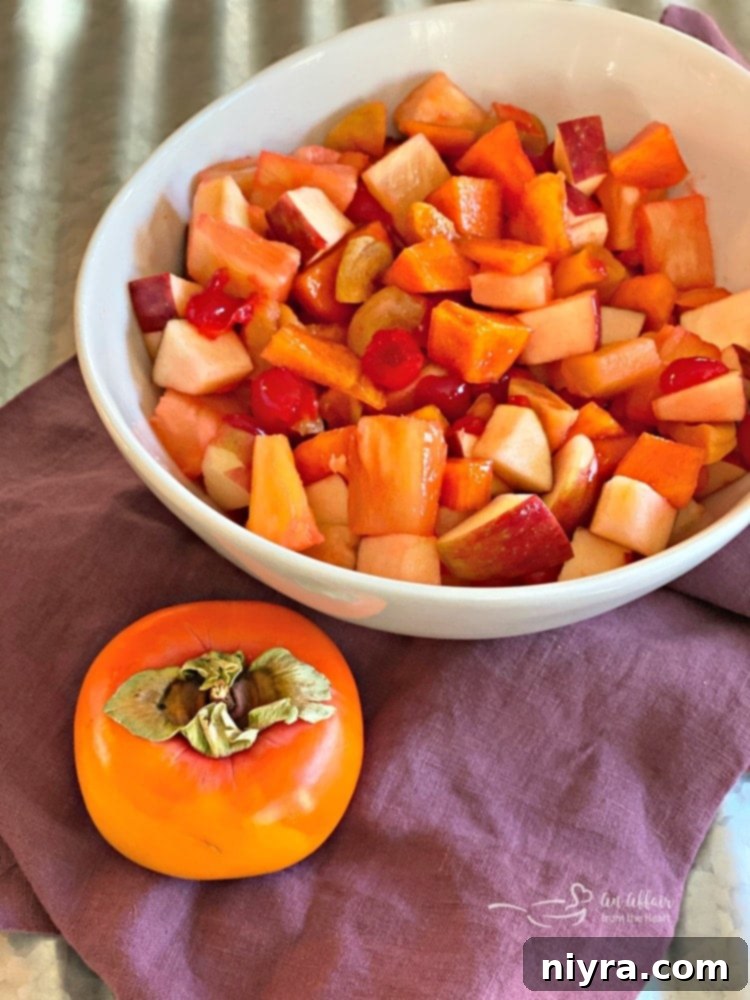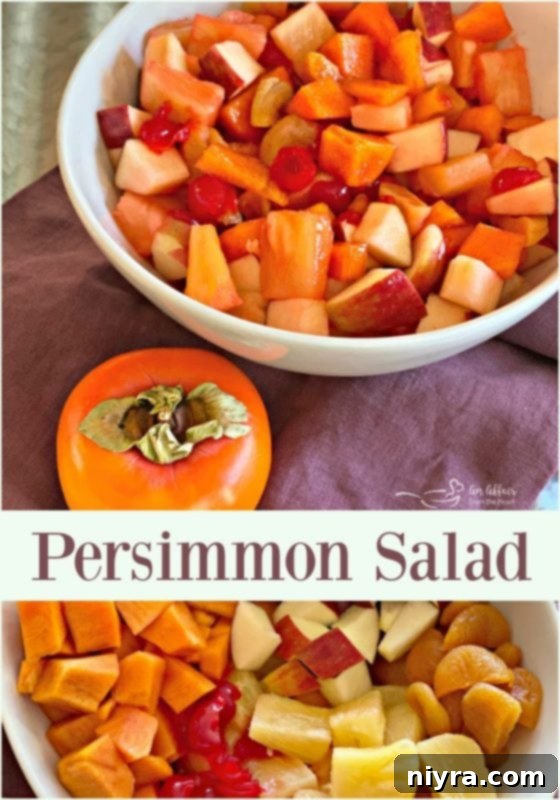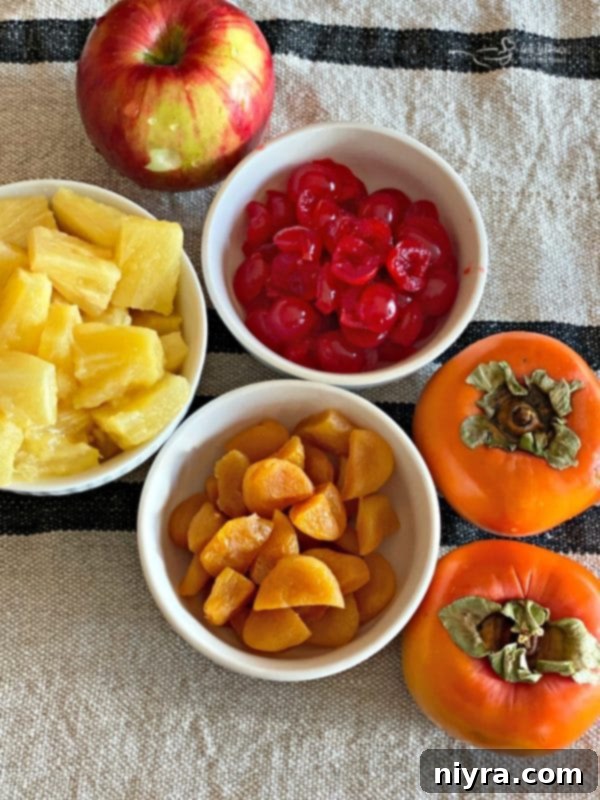Vibrant Persimmon Salad: A Delightful Winter Fruit Medley
So simple to make, yet incredibly delicious and visually stunning! This Persimmon Salad combines the unique flavors of persimmons with crisp apples, juicy Maraschino cherries, sweet pineapple, and tender apricots, creating a perfect and beautiful winter side dish.

Discovering the Charms of Persimmons
Persimmons offer a fascinating culinary adventure, often seen as an exotic and somewhat particular fruit. For many unfamiliar with its nuances, embracing the persimmon can be a bit challenging. The key to truly enjoying this unique fruit lies in consuming it at its absolute peak of ripeness. Misjudge this crucial timing, and you risk an unpleasant encounter with astringent and bitter tannins. The sensation can be quite startling, often likened to the raw taste of aspirin followed by licking a battery – a truly unforgettable and not-so-pleasant experience!
However, for those who exercise patience and select their persimmons wisely, the reward is immense. A perfectly ripe persimmon delivers a flavor profile that is wonderfully complex and sweet. Imagine the juicy sweetness of a ripe apricot, drizzled with honey, and finished with a hint of caramel-coated red apple. This remarkable taste, combined with their naturally gorgeous, often vibrant orange hue, makes persimmons an exceptional addition to any fruit salad, especially during the cooler winter months.
Types of Persimmon: Navigating Your Choices
Often regarded as a “winter fruit,” persimmons typically ripen and are harvested during the colder seasons, particularly in warmer climates where they thrive. When exploring persimmons, it’s essential to understand the different varieties available. In most domestic supermarkets, you’ll primarily encounter two main types: the Hachiya and the Fuyu persimmon.
Beyond these two common varieties, a world of other persimmons exists, including Izu, Jiro, Suruga, Hanagosho, Midia, and Shogatsu. For those seeking guaranteed sweetness, any variety ending in “Maru,” “Jiro,” or “Fuyu” is generally a safe bet, as these are known for their delightful sugary profiles. Conversely, there are numerous astringent varieties such as Eureka, Tamopan, Tanenashi, and Gailey. These types require extreme ripeness before consumption to avoid their potent, mouth-puckering tannins.
Originally native to Asia, persimmons are now cultivated worldwide, including extensively throughout the United States. The most crucial distinction to grasp when purchasing persimmons is the difference between sweet and astringent varieties. Sweet persimmons are far more forgiving if not perfectly ripe, making them an excellent choice for newcomers. Astringent varieties, while incredibly delicious when ripe, demand precise timing. If you’re ever unsure about a persimmon’s ripeness, a tiny taste test is all you need. If your tongue reacts with a raw, fuzzy sensation reminiscent of licking a tennis ball, it’s best to set the fruit aside and allow it to ripen further.
Fuyu Persimmons: The User-Friendly Choice
Fuyu persimmons are celebrated for their sweet taste and, most importantly, their edibility even when still firm. Their squat, wide, and round shape often draws comparisons to a beefsteak tomato. This characteristic firmness makes them ideal for slicing and dicing, maintaining their structural integrity in dishes like our Persimmon Salad.
Hachiya Persimmons: The Art of Patience
In contrast, the Hachiya persimmon is best enjoyed only when exceedingly ripe, often to the point of being overtly soft. Don’t be tempted to discard a Hachiya that appears too soft or mushy; this is precisely when its flavors are at their peak. Hachiya persimmons typically feature a more tapered end, resembling the shape of a turnip or an acorn. If consumed before reaching this jelly-like ripeness, Hachiya persimmons are intensely astringent. While Fuyus offer a bit more leniency in their ripeness window, I strongly recommend opting for the Fuyu variety for a consistently pleasant eating experience in fruit salads, especially for those new to persimmons.
Don’t forget to save this delightful recipe to your favorite Pinterest board so you can easily revisit it!
How to Tell if a Persimmon is Ripe and Ready
Understanding the ripeness cues for both Fuyu and Hachiya persimmons is crucial for maximum enjoyment. For a Fuyu, the fruit will develop a melon-like texture – soft yet firm, and delightfully juicy with a burst of sweetness. It should yield slightly to gentle pressure.
The Hachiya, on the other hand, will exhibit a much softer, almost mushy texture when ripe. Think of an overripe banana that’s perfect for mashing into banana bread. While this texture might initially deter some, the rich, delicious flavor of a ripe Hachiya is absolutely worth experiencing. Some might even describe its ideal texture as akin to a luscious pudding. For a fruit salad where you want distinct pieces of fruit to stand out, the Fuyu persimmon is generally the better choice. However, if you thoroughly mash a ripe Hachiya, it can transform into a wonderful, flavorful dressing component, adding complex and delicious layers to your salad. Either variety, when properly prepared, will infuse your dish with the unique taste of persimmon.
Simple Steps to Eat a Persimmon
Preparing a persimmon is straightforward. Begin by carefully cutting off the leafy green top. For Fuyu persimmons, you can then slice it in half and either scoop out the tender flesh or cut it into chunks with the skin still on. The skin is typically thin and only slightly waxy, making it perfectly edible. For a very ripe Hachiya, which tends to be much softer, simply cutting it in half and scooping out the succulent interior with a spoon is usually the easiest and most enjoyable method.
The Remarkable Health Benefits of Persimmon Fruit
Beyond their delightful taste and beautiful appearance, persimmons are a nutritional powerhouse, brimming with essential vitamins and dietary fiber. They are remarkably low in fat and packed with beneficial minerals, making them an excellent choice for a healthy diet. Persimmons are an abundant source of Vitamin C, many B vitamins, and a significant amount of Vitamin A, crucial for vision and immune function. Additionally, they provide a wealth of helpful minerals, including copper, manganese, and potassium, all vital for various bodily functions. Incorporating persimmons into your diet, especially through a refreshing fruit salad, is a delicious way to boost your nutrient intake.
Whip Up This Exquisite Persimmon Fruit Salad Today!
Each year, my thoughtful cousin, Shirley, generously sends me a shipment of delicious persimmons from California, along with new recipe ideas. This year, she shared this fantastic fruit salad recipe, which I was eager to try. While persimmons might not be a common staple in every household, especially in regions like the Midwest, you can typically find this delightful winter fruit at most supermarkets or specialty stores like Fresh Thyme or Whole Foods during this time of year. I’ve curated many fruit salad recipes over the years, but none quite like this unique Persimmon Salad. It truly stands out.
If you’ve never tasted a persimmon before, I encourage you to be adventurous and give it a try. They are a genuinely unique and undeniably delicious fruit that adds an exotic twist to any dish. Shirley’s original persimmon salad recipe calls for Fuyu Persimmons, fresh apple, canned pineapple chunks, Maraschino cherries, and dried apricots. Fresh apricots would also be a wonderful substitute if available. I made a minor tweak to the recipe to suit my preference: I found that the cherry juice made an already sweet fruit salad a bit too saccharine, so I opted to add more pineapple juice instead. This adjustment created a perfectly balanced sweetness that we absolutely adored!
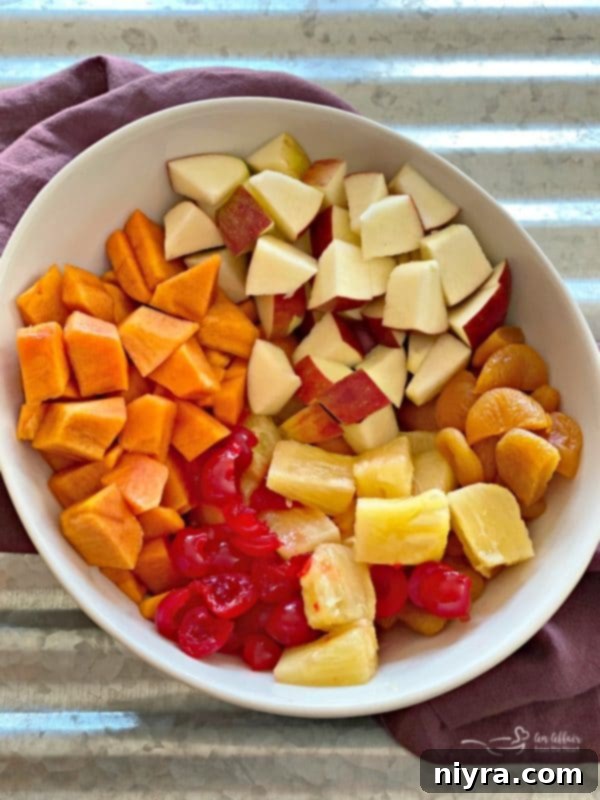
The result is a wonderfully colorful and pretty salad that brings a festive touch to any table, making it an especially great addition to holiday feasts or special gatherings. This Persimmon Salad is not just a treat for the palate but also a feast for the eyes, guaranteed to impress your guests.
Other Creative Ways to Enjoy Persimmons:
- Persimmon Cookies
- Persimmon, Pomegranate, and Spinach Salad
- Persimmon Apple Cider Mimosa
- Fall Harvest Salad
- Persimmon Ginger Sorbet
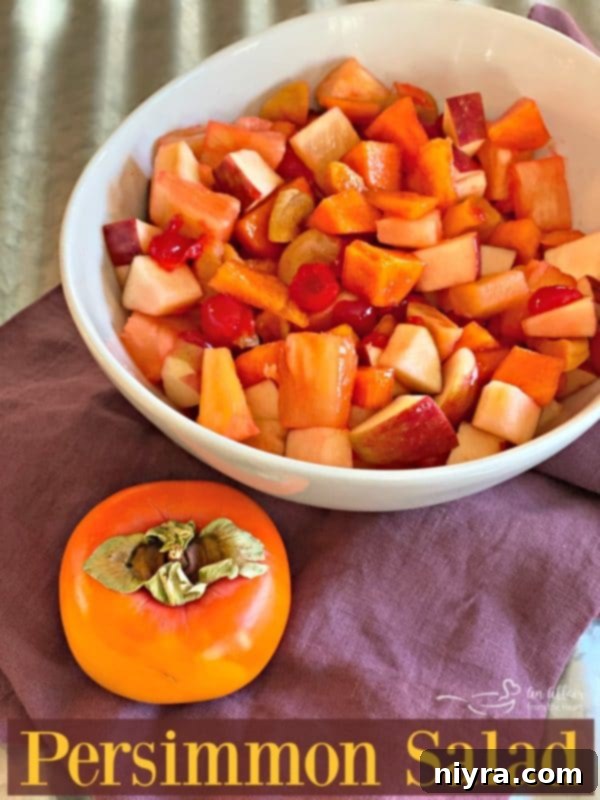
If you prepare this simple persimmon salad recipe now, you can be savoring its refreshing flavors in just a couple of hours after it has chilled. Let’s get started on this delightful dish!

LIKE THIS RECIPE?
Don’t forget to give it a ⭐⭐⭐⭐⭐ star rating and
leave a comment below the recipe!

Print Recipe
Persimmon Salad
Ingredients
- 2 persimmons peeled and diced
- 1 apple diced, skin left on
- 5 ounces Maraschino cherries halved
- 1 cup dried apricots halved
- 20 ounce can of pineapple chunks drained
- 2 Tablespoons cherry juice
- 4 Tablespoons Pineapple juice
Instructions
- Combine all ingredients in a bowl, cover, and place in the fridge for a couple of hours. Fruit salad is ready when apricots are re-hydrated.
